Planeswalker's Guide to Kaldheim, Part 1
WELCOME TO VIKING WORLD
Kaldheim is inspired by Norse legends and mythology, and the themes of the ancient sagas run throughout the entire setting. It is a massive plane made up of many individual realms, so there is much for any traveler to learn. In the first part of this guide, we'll be going over the general workings of the plane, as well as the human realm of Bretagard.
THE TEN REALMS AND THE WORLD TREE

The world was born from a seed, and that seed grew into the World Tree, and everything else grew from it. Its leaves were every color imaginable, and as its branches spread out, they became worlds themselves. And once there were ten strong branches, fruit grew on the branches, and those were the Cosmos monsters. The serpent was the firstborn, and he has been growing since before the beginning of time.
— The First Saga
The realms of Kaldheim are mini-planes that are all connected to a cosmic structure that births them, and they rotate around it in unpredictable ways. The peoples of the realms see this structure as a vast, living tree—the World Tree—that is the origin of all life, growing in a vast nothingness. Inside the realms, the World Tree manifests as a physical tree and its branches can be seen in the sky. There are other realms outside of the ten in Kaldheim, but it is not yet time for their story.
The Light of Starnheim

Throughout all the realms, the Hall of Valkyries can be seen in the sky as a "sundog" effect, similar to what happens to the sun on a cold sky. It is known as the "Light of Starnheim," and denizens keep symbols that represent it.
THE COSMOS
The space between realms, a nebulous space filled with shifting lights like an aurora, is known as the Cosmos. It's challenging, but not impossible, for denizens of one realm to cross the Cosmos and enter another realm.
Cosmos Monsters
Magical creatures known as Cosmos monsters live and thrive in the space between the realms. Most of them resemble a recognizable animal, such as a wolf or eagle, but grown to prodigious size and enhanced with mystical abilities and supernatural knowledge. The peoples of Kaldheim believe that when the Cosmos monsters were born, all the secrets of the world—including events that hadn't yet happened—were locked inside their minds. Mages from many realms, and even gods, have devoted their lives to unlocking those secrets.
These monsters are incredibly old. They are said to be the first "fruits" of the World Tree, and they now serve as its guardians, maintaining the structure of the plane and its realms. Most of the Cosmos monsters can move freely between the realms, often bringing havoc and destruction with them when they enter a realm.
The Cosmos monsters share little in common besides dwelling in the Cosmos. They vary in size from the unimaginably massive Cosmos Serpent to the tiny, mischievous squirrel Toski, who is small enough to sit in the palm of Esika's hand. Many of the Cosmos monsters are well-known, appearing in numerous sagas, while others have never been seen and their deeds are unknown. Some might be larger than the World Tree—a thought that inspires fear even in the hearts of gods.
Koma, the Cosmos Serpent
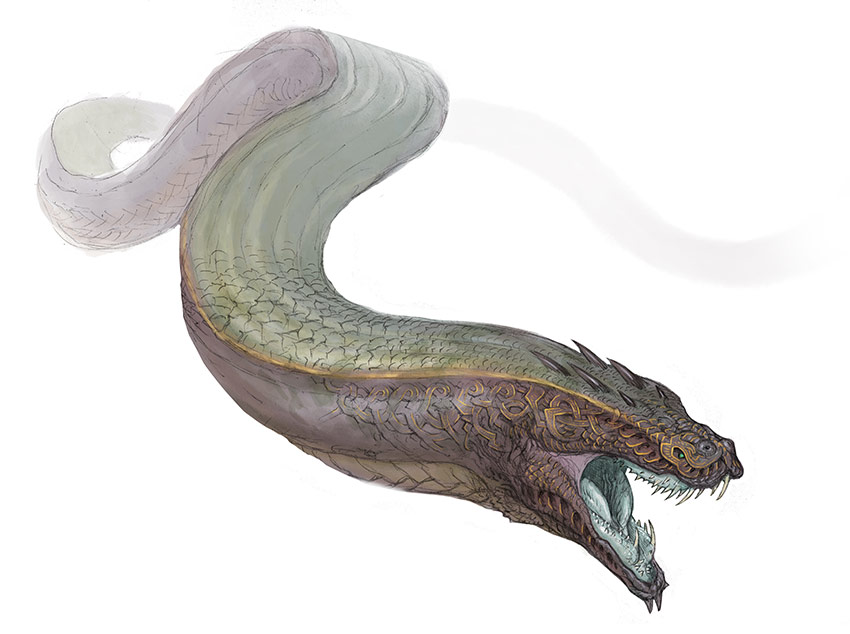
The Cosmos Serpent is the first and oldest of the Cosmos monsters. His true size is unknown, because he can divide himself into multiple smaller segments that move independently around the World Tree.
Most of the Cosmos monsters are free to enter any realm. But when the Skoti overthrew the Einir gods, they also prohibited the Cosmos Serpent they revered from entering any of the realms. Perhaps they were afraid that Koma would enter Skemfar and free the imprisoned Einir, or maybe they feared that the immense serpent would eventually grow large enough that no realm could contain him. In any case, the elves, who continue to worship Koma, believe that his banishment harms the World Tree. Restless outside the realms, Koma's agitation is destabilizing the tree, causing a dangerous increase in Doomskars. The elves believe that unless the Cosmos Serpent is free to roam the realms, the World Tree will surely die—and all the realms with it.
Crossing the Cosmos
An ordinary person thrust into the vast Cosmos without the proper magic would initially be disoriented, then terrified, and would soon succumb to madness. Cosmos monsters would be drawn to the hapless traveler and probably devour them quickly. Even if they happen to avoid the monsters, there is no food or water, and navigating the Cosmos is nearly impossible. But given the right kind of magic—a special spell, a god-weapon, or a ship inscribed with powerful runes—it's possible to cross through the Cosmos and travel from one realm to another.
Omenpaths: As realms shift on the World Tree, passages called Omenpaths sometimes open between realms. Inhabitants of one realm can use an Omenpath to reach another one. Sometimes this is as simple as walking through a shimmering light on the landscape, but other Omenpaths are more treacherous and involve crawling through shifting tunnels and being deposited unexpectedly on the mountaintop of an unfamiliar realm. Once an Omenpath between realms has opened, some powerful mages can close and reopen them at will. The opening of an Omenpath is often a precursor to the two realms overlapping in a violent Doomskar.
Doomskars: Although each realm is distinct, they are all in constant motion around the World Tree, and sometimes they overlap. Such an overlap is called a Doomskar, and it's a violent, explosive event marked by world-altering earthquakes and geological destabilization. Inevitably, the inhabitants of the overlapping realms come into conflict.
Gods: Because of the Cosmos Elixir that makes the gods what they are, the gods are immune to the disorienting effects of the Cosmos and can cross between the realms more easily than other races. It's still a challenging journey to simply walk between planes, so they often use magical objects that open an Omenpath or, in rare cases, transport them directly between realms.
Shapeshifters and Omenseekers: Shapeshifters' ability to change form and the Omenseekers' rune-enhanced longboats both enable passage between realms.
THE GODS OF KALDHEIM
The current ruling family of gods, the Skoti, supplanted the ancient Einir a few centuries ago. The descendants of the Einir are the shadow elves and wood elves, whose power is greatly diminished.
While there have been multiple "families" of gods, they have all had a cosmic connection to the essence of the World Tree. The elves believe that the Einir used to channel it through their connection with Koma, while the Skoti imbibe a magical "Cosmos Elixir" created by Esika, the god of the World Tree. The Cosmos Elixir also slows their aging and maintains their supernatural powers.
The Skoti are incredibly powerful, but they are also selfish, prone to bickering, and constantly causing trouble in the realms. In addition to being exceptionally strong, fast, or nimble, each god has special powers and abilities connected to their sphere of influence. The gods have strong personalities, and each is involved in a tangled web of relationships with their kin. While each god is individually powerful, their internal conflicts are becoming increasingly problematic for the plane.
Tyrite
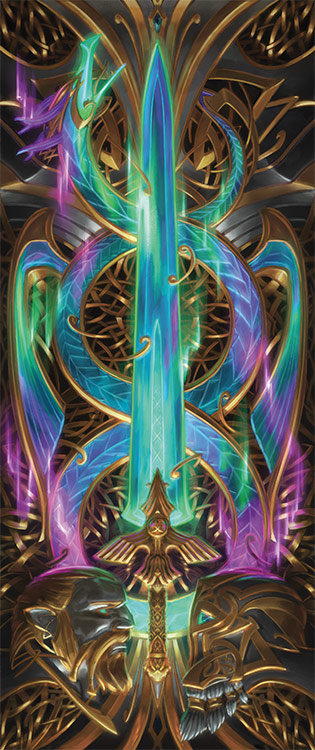
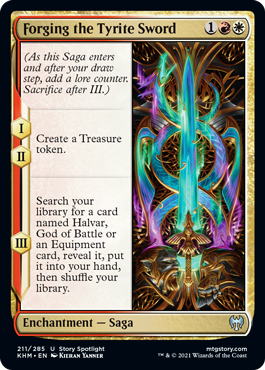
The gods use a highly magical substance derived from the "sap" of the World Tree. Tyrite looks like the aurora-like lights of the Cosmos given solid form. While the gods may handle it safely, direct contact with Tyrite is quite dangerous for mortals.
Because Esika, the god of the World Tree, makes her Cosmos Elixir from Tyrite, the Skoti's skin or other aspects of their appearance show the influence of the aurora lights in subtle (and sometimes not so subtle) ways.
The Skoti
Alrund is the god of wisdom. He won his extensive knowledge by battling the Cosmos monsters.

Reidane, the god of justice, is youthful, arrogant, fanatical, and fully committed to the cause of justice.
Halvar, the god of battle, is selfless, stalwart, unwavering, and always the most sensible person in any room.
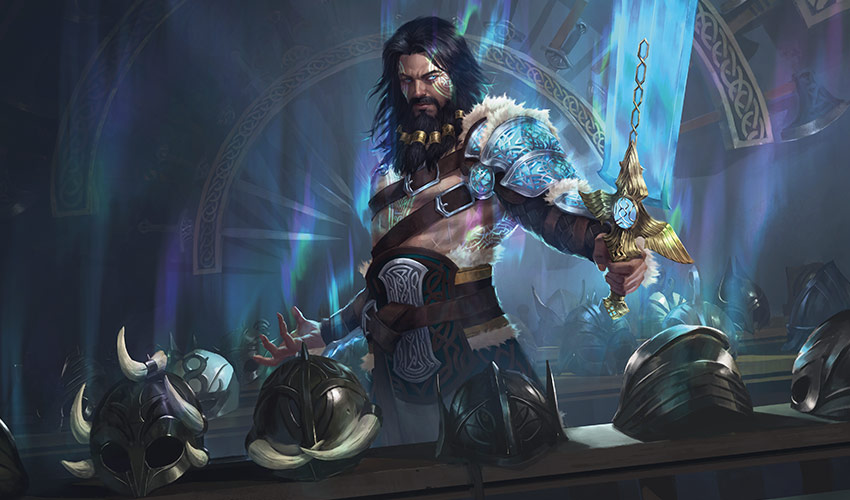
Egon, the god of death, is one of the oldest of the gods, but he ages backwards. He has the appearance (and the bitter, negative attitude) of a teenage boy.
Toralf, the god of thunder, is a fearless risk-taker with a passion for wild feats and saga-worthy adventures.
Birgi is the god of boasting. Fun-loving and charismatic, she is always the center of attention as she travels across the realms.
Cosima, the god of the sea, is intensely curious and tempestuous. Born a Cosmos monster, she can't stand being in one place for too long.
Tergrid, the god of fear, is an accomplished warrior whose shadow has a terrifying life of its own.
Valki is the god of lies. Vain and selfish, he causes no end of trouble for the other gods. On purpose, of course.
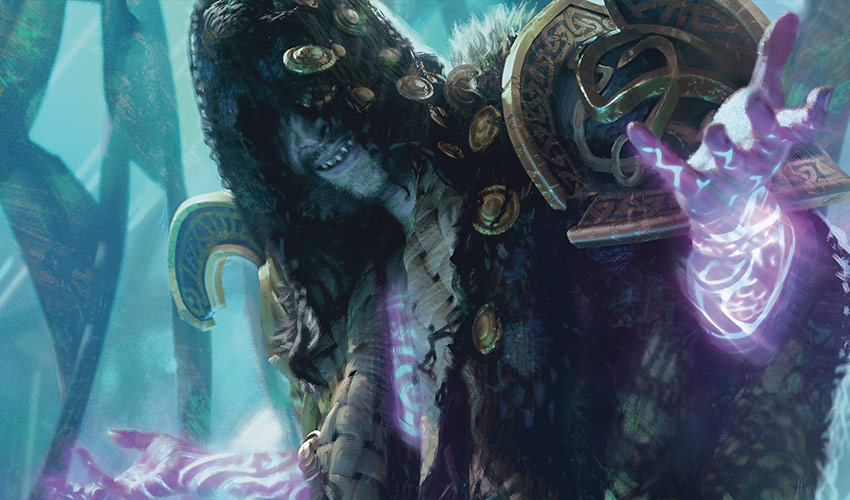
Esika is the god of the World Tree. She creates the Cosmos Elixir that allows the gods to maintain their supernatural power.
Kolvori is the god of kinship. Talkative and exuberant, she cares deeply about the fate of her divine family.
Jorn is the god of weather. He is an exceptional tracker who knows the swiftest, safest paths across (and between) every realm.
BRETAGARD

The human realm of Bretagard is home to five human clans who are in perpetual conflict with each other. Each clan has its own unique approach to both martial combat and magic. Bretagard consists of a single large continent surrounded by a perilous, storm-tossed sea. The land is dominated by a sprawling plain, called the Feltmark, which stretches hundreds of miles from the ocean to the ancient woods of the Aldergard Forest. Across the land, plant and animal life is diverse and plentiful.
Feltmark
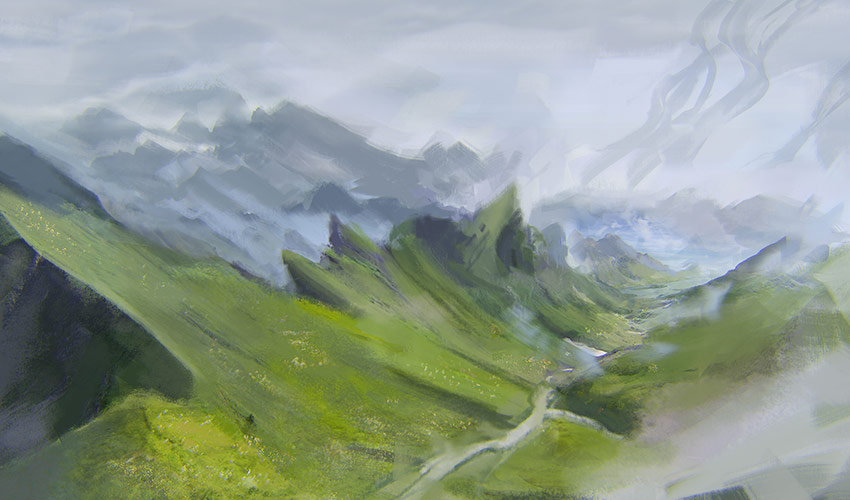
The immense, grassy plain of the Feltmark covers more than half the total land area of Bretagard and holds the greatest concentration of human population. The verdant land is also a habitat for elk, reindeer, moose, goats, lemmings, foxes, lynxes, birds of prey, and wild pegasi. The Beskir clan—known as both fierce warriors and Lawspeakers who enforce the Code of the Clans—make their homes in the Feltmark. Though small villages are scattered across the plains, most of them are concentrated within a day's ride of the largest settlement, Beskir Hall.
The thriving village of Beskir Hall is built on high ground about a mile from the coast. The sharp ascent to the village makes it easily defensible against attacks by land, and its view of the western sea gives the Beskir ample warning should raiding ships come near. The central longhall that gives the village its name is decorated with intricate carvings commemorating legendary feats, blood duels, and the signing of the Code of the Clans. High wooden walls inscribed with magical wards grant some additional protection against invaders.
Beskir
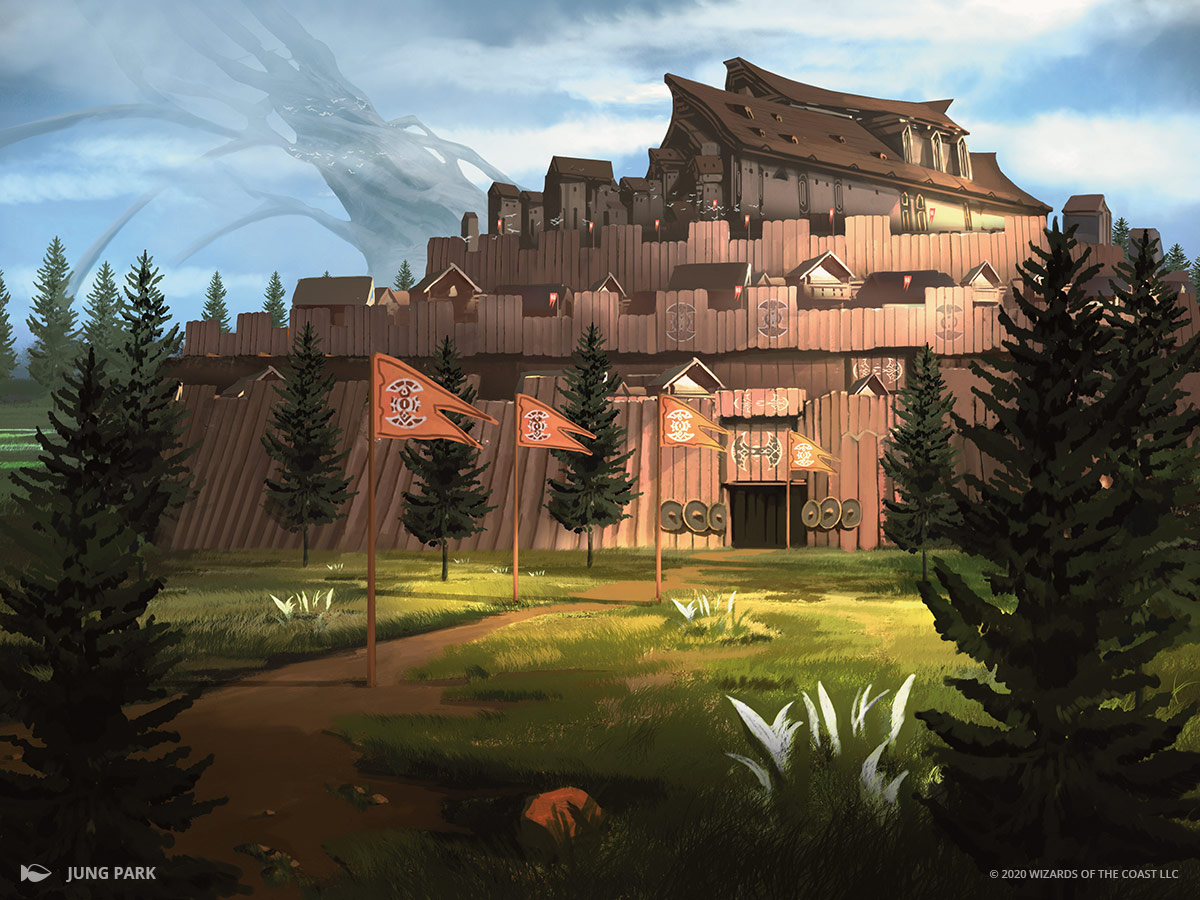
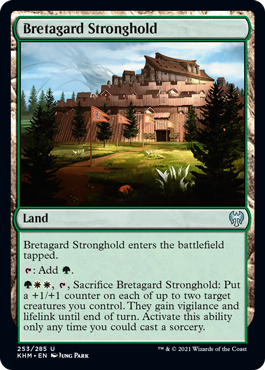
Settled in the grasslands surrounding the grand longhall that bears their name, the Beskir clan is dedicated to maintaining peace, order, and law throughout their territories. Widely acknowledged as impartial adjudicators, the clerics of the Beskir—the Lawspeakers—enforce the Code of the Clans and settle arguments within and among all the clans of Bretagard. But only a fool would assume that their dedication to law and peace makes the Beskir weak, for their warriors are as fearsome as any Skelle or Tuskeri raider, and far more numerous. The Beskir are led by two women: Maja and Sigrid. Sigrid, the clan's spiritual leader, traces her lineage back to the legendary warrior Hurrik, who is said to have saved the god Alrund's life.
Hurrik was hunting when he stumbled upon a man fighting a giant wolf. He quickly noticed that this was no ordinary wolf—this was one of the Cosmos monsters born from the fruits of the World Tree. And the man, too, was no ordinary man. It was Alrund, god of wisdom, who had decided to fight every Cosmos monster, from the youngest to the oldest. Alrund believed that, as he fought the Cosmos monsters, the nature of the Cosmos would be revealed to him. He didn't want to kill the monsters (although he would, if things went badly for him), he just wanted to learn from them.
When Hurrik came upon him, Alrund had gained the upper hand on the great wolf—but he didn't realize that the wolf's teeth had been coated with poison by a rival god. When the fangs pierced his forearm, Alrund fell to the ground, paralyzed and helpless. Just as the wolf was about to rip out Alrund's throat, Hurrik shot an arrow into its eye. It roared in pain and ran away.
Alrund, relieved and grateful, thanked Hurrik for his swift intervention and gifted the whole of the Feltmark to Hurrik and his descendants. Then he left Bretagard and continued his journey to fight every Cosmos monster, undeterred by his brush with death.
— The Wolfbreak Saga
Code of the Clans
Generations ago, representatives from all five clans signed a blood pact to abide by a common code of law governing the relationships among the clans. This Code of the Clans provides a system of recompense to be enforced when a member of one clan brings harm to a member of another. For example, a murderer owes a debt to the victim's surviving family—and the severity of that debt depends on the family member's relationship to the victim. Recompense might be paid in gold, livestock, or other property, in a period of servitude, or in blood.
The Code of the Clans names the Beskir clan as its defenders and adjudicators. Their role is to weigh evidence and declare the appropriate punishment or recompense for the crime, but not to exact that punishment. The guilty party is expected to pay what they owe, or failing that, their clan must force payment. If the clan fails in this duty, the victim is expected to take matters into their own hands.
Even the relatively lawless Tuskeri and Kannah clans bring their disputes with other clans to the Beskir for judgment, though the Lawspeakers' influence is not as strong in the wilder lands beyond the Feltmark. The Skelle raiders forswore the Code of the Clans when they launched the Bloodsky Massacre, and now they consider themselves beyond the reach of the Beskir Lawspeakers.
The Beskir clan's devotion to justice and order is evident in their own laws, which extend beyond the requirements of the Code of the Clans in prescribing the behavior of the Beskir. Their strict codes of conduct govern how they treat each other, strangers, visitors, and even enemies and prisoners. Thanks to these codes, the Beskir are famed for their hospitality, even to nonhuman visitors from other realms. Some of the sagas told among the Beskir involve gods or other powerful beings coming to Beskir homes in disguise and either richly rewarding those who show them hospitality or punishing those who fail to welcome them.
Kirda Seas
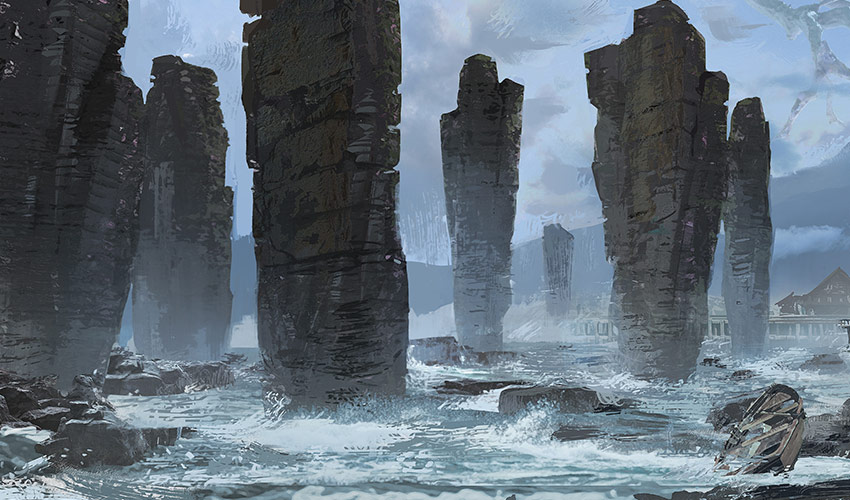
Bretagard's land is surrounded by the rough, icy waters of the Kirda Sea—which most humans take pains to avoid. Countless sagas speak of sea monsters that lure boats to watery graves or assume human form and murder villagers in their sleep. Monsters aside, the waters themselves are treacherous, with towering sea stacks and jagged rocks lining the coast, often hidden by thick fog.
The Kirda Pillars are a maze of sea stacks perpetually shrouded in chilling mist, forming the most dangerous region of the coastal waters. Naturally, the Omenseekers—the most expert sailors of Bretagard, aided by runic navigation magic—call the Kirda Pillars home.
Once a season, all the clan's navigators return to the network of docks at the heart of the pillars and moor their longships as they share their sea charts and discoveries. The rest of the year, though, the docks are almost completely empty as the Omenseekers spend their days traveling and exploring.
Many of the pillars are inscribed with sky charts, maps, and other secrets from across the realms, but the Omenseekers guard their knowledge closely, obscuring their records with runic magic only a member of the clan can decipher.
Omenseekers
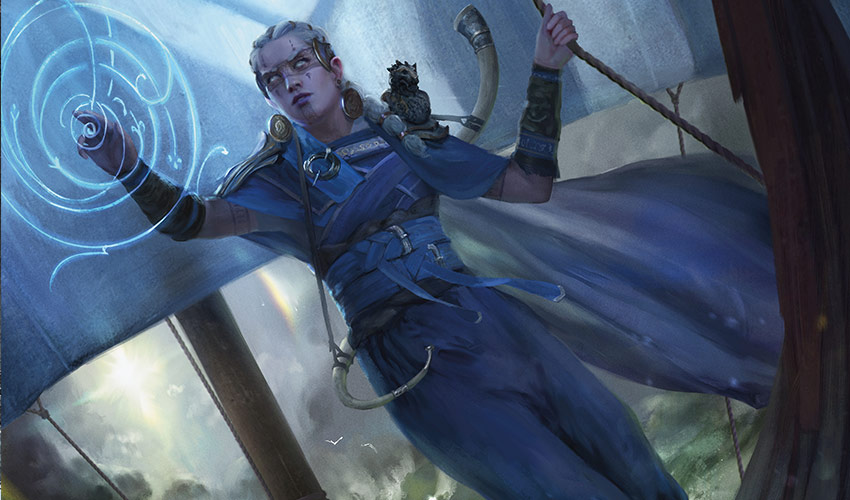
Driven by a desire to understand the secrets of the Cosmos, the fearless Omenseekers cross both the seas of Bretagard and the space between realms in search of arcane knowledge and new wonders. These mystic navigators follow sky maps inscribed with runic magic, showing both the stars of the ordinary night sky and the mystical Light of Starnheim that shines from the heights of the World Tree. Through careful charting and bold exploration, the Omenseekers hope to predict the Doomskars that occur when two realms overlap. They meet in Bretagard's Kirda Pillars once each season to share secrets they have gleaned from other realms, but they are most at home on their longships and consider themselves residents of the Cosmos. The Omenseekers are led by Inga Rune-Eyes, a blind seer who possesses all the knowledge gleaned by the clan on their voyages.
Vedrune Wizards
The Vedrune are an elite group of Omenseeker wizards who use elements from the natural world, such as ocean currents, wind, and the lights of the aurora, to predict future events as well as navigate through the Cosmos to other realms.
The most powerful Vedrune wizards can open Omenpaths to other realms, and they believe that exposure to more realms expands the power of their magic. They prefer trickery and strategic ruses to outright combat, but if they can't avoid it, they fight with elemental magic and elemental creatures. The Vedrune have strong ties to frost giants, and it's not uncommon to find a Vedrune apprenticing with a frost giant in Surtland where they learn to wield snow and ice.
Skelle Mire
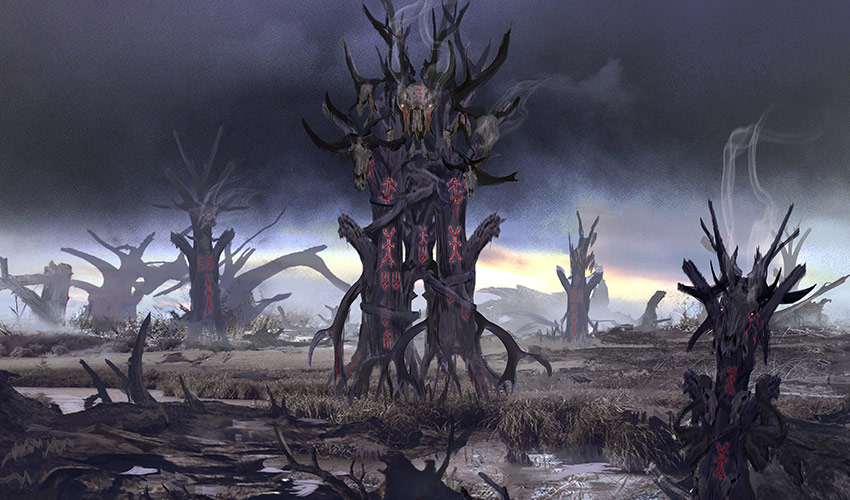
The Aldergard contains vast tracts of marshland. Some of these are seasonal, flooding when the summer sun melts the snow and thaws the frozen ground, but others are permanent, turning to ice and slush in the colder seasons. The largest of these permanent swamps is the Skelle Mire, a dark place near the center of the Aldergard.
The Skelle Mire gives its name to the clan of brutal raiders that lives in and around the marshland. The Skelle have built a network of magical pathways across the mire that are visible only to themselves. Outsiders quickly lose their way in the marsh or get mired in mud, making them easy prey for the prowling Skelle raiders.
Skulder's Mound is the central base of operations for the Skelle clan. The Skelle have built a crude longhall on top of the skull of a huge, long-dead beast that is half-sunken into the swamp and covered in mossy growth. Ominous glowing runes are scratched into almost every inch of the forbidding structure, evidence of the Skelle's strange, deadly magic.
Skelle
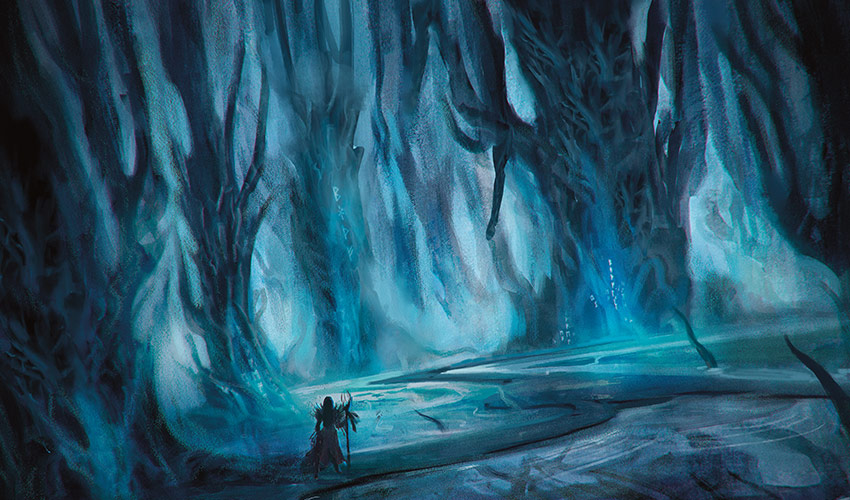
Once a band of violent outcasts, the Skelle clan decided long ago that it was easier to take resources from other clans by force than it was to scratch out a meager living in the swamp.
Vicious and supernaturally quick, they can carry out raids miles away from their home base in the Skelle Mire then disappear without a trace even in the open grasslands. They are by far the most feared clan in Bretagard, to the point where many believe that even speaking their name can bring doom to one's village.
Tactics of Conquest
The Skelle rely not just on berserker ferocity but also on sinister magic to conquer villages and exact tribute from them. They make regular rounds to their conquests, demanding tribute of food, valuable goods, and money in exchange for the "privilege" of being allowed to live. Any village that refuses to pay tribute is immediately and utterly destroyed.
When the Skelle conquer a village, they leave most of the population alive, but they stake their claim on the village and exert control over the survivors by erecting scorn poles: fire-blackened, rune-etched pillars that magically sap both the physical strength and the will to resist from the villagers. Tearing down a scorn pole is tantamount to rebellion, and the Skelle do not allow rebellious villages to survive.
Particularly headstrong villagers with the potential to foment rebellion are branded with death marks created by the Skelle's unique and brutal runic magic. A death mark slowly drains the life force of its bearer and siphons that strength to the raider who created the mark.
Varragoth
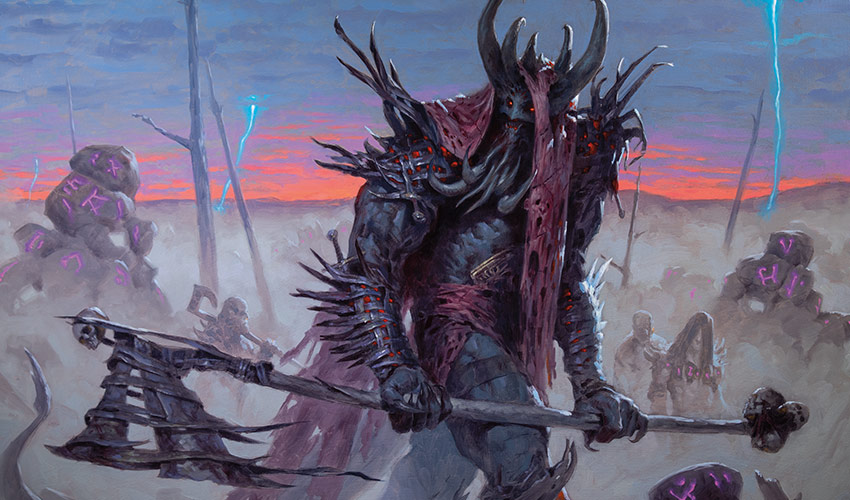
The Skelle clan became the terrible force it is today under the tutelage of Varragoth, a demon who escaped from Immersturm. The demon has long since been banished back to Immersturm, but the Skelle still revere him, follow his violent ways, practice his deadly magic, and even costume themselves in his likeness. They believe the demon will return one day and lead them in finishing the work that he began, wiping out or subjugating the other clans entirely, so only the Skelle remain.
Varragoth escaped Immersturm through incredible pain and effort. Once in Bretagard, he quickly established himself as the leader of the Skelle raiders, who were all too happy to ally themselves with a demon. He led them to Beskir Hall, slaughtering anyone they found along the way. The few Beskir who escaped begged the gods to intervene before the Skelle wiped out their clan entirely. The gods, seeing the violence wrought by this intruder from another realm, stepped in and battled Varragoth for an entire month across the realms before, finally, they wrestled him back to Immersturm and restored the wards meant to keep demons bound there. On Bretagard, the winter season is still known as Bloodsky in memory of the massacre—and as a reminder of the ruin wrought by those who abandon the Code of the Clans.
— The Bloodsky Massacre Saga
Tusk Mountains
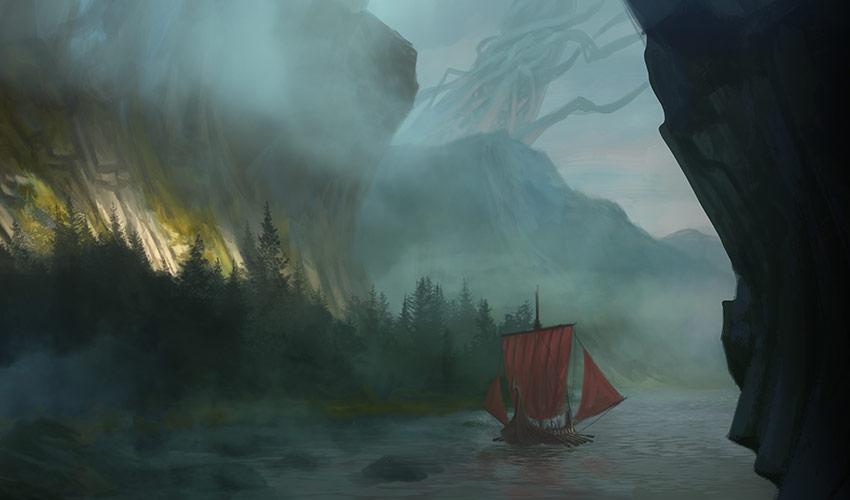
The jagged, inhospitable Tusk Mountains dominate the eastern side of the continent. The peaks are covered in snow year-round, but plenty of hardy animal species still thrive there, including boars, bears, wildcats, and a variety of smaller mammals.
The raucous warriors of the Tuskeri clan take their name from the mountains and hold nothing but disdain for the "soft" clans of the lowlands. They hunt boars and mountain goats for their food, having little interest in agriculture. They prefer to descend to the Feltmark only to raid, complete some outrageous feat, or on rare occasion, attend a Beskir feast.
Tuskeri
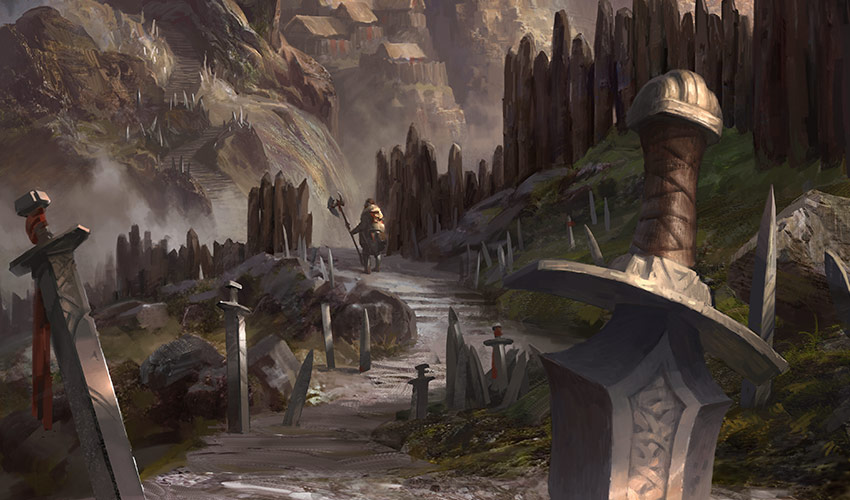
Tuskeri society is chaotic and revolves around glory and boasting. They are driven to complete dangerous feats and go on wild adventures—the kind of adventures that become sagas sung for generations. They all aim to perform bigger, better feats than anyone else in all the realms and goad each other into attempting outlandish tests of strength and skill. They frequently visit Axgard in search of dwarf skalds to accompany them on their never-ending adventures, since the word of a skald is the closest possible thing to proof of a story's veracity.
The Tuskeri like to go to war and usually don't need any excuse beyond being bored, realizing they haven't had a good fight in a while, or hearing someone say something more insulting than usual. They are very enthusiastic but disorganized fighters, with no appetite for strategy or careful tactics. Rather, each individual fighter attempts the most over-the-top heroic feats they can dream up, regardless of what their allies are doing. Nothing is more glorious to them than dying heroically in battle; not coincidentally, Tuskeri warriors are also more likely than those of any other clan to be spirited away by the Valkyries to the glory of Starnheim.
Trophies, mementos, and prizes from Tuskeri exploits become focal points of their storytelling—in fact, the very hall they call home is a trophy made from the discarded helmet of a giant. Captured weapons, mysterious artifacts, and bizarre animal skulls and hides hang on every wall, and each one has a story known to all the Tuskeri.
The Tuskeri are great drinkers and brewers of mead, and at least one mountain goat is always roasting on a spit over the central fire of their hall.
Leadership among the Tuskeri falls to the clan member who is seen as the strongest, boldest, and most accomplished at any given time. The position of leader can be bestowed as a reward for particularly remarkable feats, which means that the office can pass at any time to the next warrior who achieves something incredible.
The current leader of the Tuskeri clan was formerly known as Arni Goatleaper, but like other Tuskeri, he changed his appellation based on his latest and greatest deeds: in his case, winning a headbutting contest with a troll at some personal cost.
The Aldergard
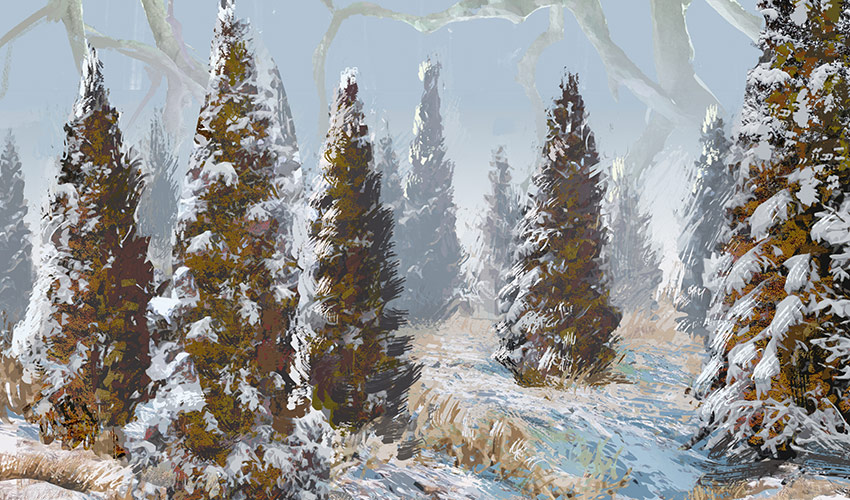
The Aldergard is an ancient forest of pine, yew, and deciduous trees stretching between the fields of the Feltmark, on the west and south, and the slopes of the Tusk Mountains on the east. The edges of the forest are sun-dappled and welcoming, but toward the center, the trees grow together into a seamless twilight canopy.
Kannah
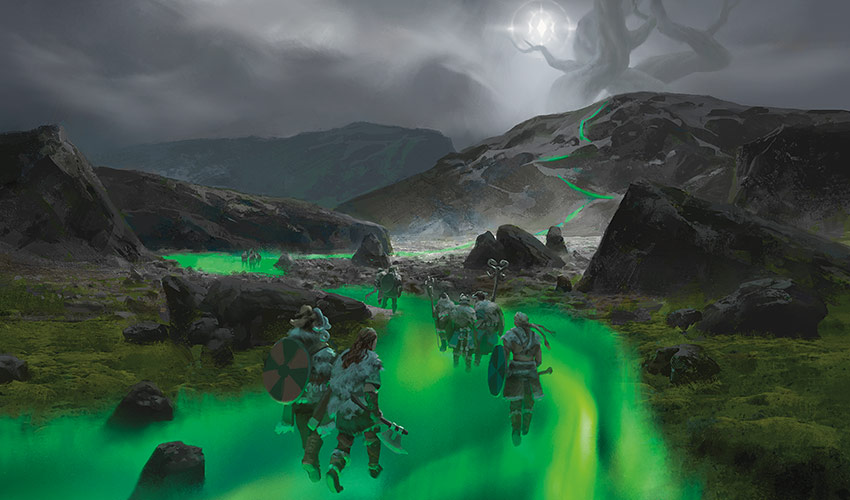
The forest is home to the nomadic Kannah clan, who maintain temporary settlements in the forest but regularly send groups on exploratory expeditions. Some such expeditions even extend into other realms as the Kannah search tirelessly for a path to Starnheim. The Aldergard is so large that some Kannah wander for years without ever leaving the forest.
Near the eastern edge of the forest, in the highlands rising into the Tusk Mountains, stands the Cursed Tree—a massive oak that is perpetually covered in snow. Kannah sagas say that this is the site where a god cursed them to remain forever in the Aldergard, with no hope of entering the hallowed halls of Starnheim. If the Kannah leave the forest, winter follows them and torments them with constant, increasing snowfall, eventually making forward progress impossible and forcing them to turn back. The Kannah maintain a small settlement near the Cursed Tree, where they perform runic rituals in hopes that one day the curse will be lifted.
The Kannah are led by Fynn the Snakehunter, the only human who has ever managed to wound the Cosmos Serpent.
Cursed and Cursing
When the Skoti defeated the Einir, the Kannah were hopeful that their curse might be lifted, and they pled their case to the new reigning gods. But the Skoti were busy with their own boasting and squabbling and paid no attention to the cries of the Kannah, so the curse lingers.
Thanks to their ill treatment at the hands of divine beings, the Kannah despise anything related to gods, including the Cosmos monsters. They believe that killing the Cosmos Serpent will give them enough power to rise up and destroy the Skoti, end the curse at last, and claim Starnheim for themselves.
END OF PART 1
That's it for the first part of the Planeswalker's guide! Part 2 will detail the remaining nine realms in the set and the friends and foes that await within.
Worldbuilding Credits
And a special thanks to everyone who has helped bring Kaldheim to life!
Concept Artists
Alix Branwyn
Chris Rahn
Daarken
Jehan Choo
Jenn Ravenna
Jonas De Ro
Nick Southam
Randy Vargas
Sam Burley
Steve Prescott
Rebecca On
Taylor Ingvarsson
Tyler Jacobson
Viktor Titov
Zack Stella
Worldbuilding Writing Team
Jenna Helland
Ethan Fleischer
Emily Teng
James Wyatt
Annie Sardelis
Hans Ziegler
Doug Beyer
Katie Allison
Art Director
Cynthia Sheppard
Creative Producer
Meris Mullaley
Creative Lead
Jenna Helland
Creative Director
Jess Lanzillo
